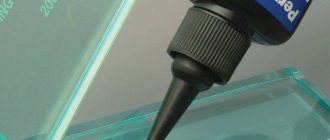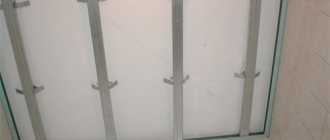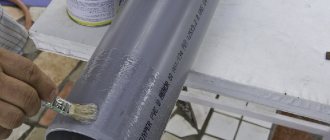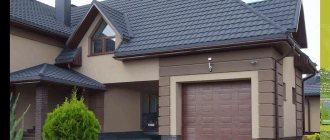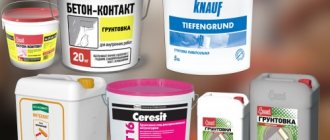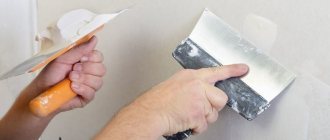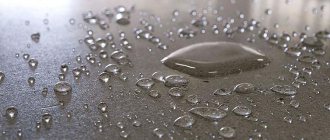I have been doing car tuning for several years now and not long ago I was faced with the question of how to glue plastic to metal. In this publication I will tell you in detail which tools do a good job of this task.
Source kraski-net.ru
Types of glue for plastic
To make it easier to find high-quality glue, you should familiarize yourself with the popular representatives that are most often found in stores and on the market. Correctly selected adhesive will reliably stick to any surface and will last for a maximum period.
It is important to know that the plastic itself has poor adhesion because it has a smooth surface. This greatly affects the quality and reliability of gluing.
In industrial enterprises, special welding is often used, as it allows elements to be connected more reliably and for a long time.
The main principle of the glue is that the surface dissolves and, after a strong blow, is crushed into a monolithic structure. Therefore, any plastic is based on a special solvent, and the composition includes wild polystyrene to ensure viscosity.
Hot melt adhesive for plastic
Bonding with heated plastic rods is not strong. Hot melt adhesives are used to fill chips and voids on plastic surfaces. Due to poor adhesion, thermal bars are not suitable for parts subject to stress. Do not use rods to glue small parts or broken flat panels.
The advantage of this option is that the glue is easily applied to the surface. This option is ideal for small operations.
Contact adhesive for plastic
This type of plastic parts can be easily glued and the adhesion quality will be high. There are two types of contact adhesives: with and without hardener. Applying both types involves the same steps. Glue is applied to one or both parts to be joined. They wait some time for the composition to stabilize, usually 10-15 minutes, then the parts are pressed against each other.
This type of composition is equipped with toxic elements, so work must be carried out in compliance with safety precautions, good ventilation is created, and substances do not enter the skin.
Glue is applied to one or both parts to be joined.
Liquid glue for plastic
Liquid adhesives are the easiest to use and therefore the most popular. Water-based and thinner versions are available. Their operating principle is the natural evaporation of solvents or water, depending on the components used. After the process is completed, hardening occurs and a reliable seam is created.
As a result, they should not be used on sealed objects; evaporation may not occur in this case. Among them, PVA, known to many, stands out, suitable for porous surfaces, with which you can stick plastic films on furniture. Dichloroethane is also of this type, but its use is harmful to health, so it is more often used in industry.
Liquid adhesives are the easiest to use and therefore the most popular.
Reaction glue for plastic
Reactive adhesives are reliable and affordable. Some reactive adhesives require external drying of the parts to be glued, others require the presence of ultraviolet rays, and others require water. All produced reaction adhesives are divided into 2 groups: one-component and two-component. Adhesives include polyesters, epoxy resins and polyurethane.
Edible glue
Such products do not emit toxic substances, which allows them to be used for gluing household items. Edible glue is in great demand among buyers. It does not cause poisoning or allergies, which is important if there are small children at home.
Benefits of Metal Adhesive in Achieving Production Goals
At all times, different methods were used to connect two metals together. This includes riveting, welding, cold welding, and recently another method has emerged - gluing. The chemical industry has moved forward, and many components have emerged that can tightly join two pieces of metal.
This method is better than the previous ones. You can buy iron glue at any hardware store. Without much skill, connect two elements, and they will hold firmly. No welding, electricity or welding machines required. Only a small tube.
Using a welding machine you can join metal to metal, but you need a good machine and uninterrupted electricity. In addition, you need to know how to use it. You can buy glue at a hardware store, and, following safety precautions, connect the necessary elements according to the instructions. This is the advantage of this method.
The best superglues for plastic
The most popular method for gluing broken parts or assembling miniature models is superglue. The name itself speaks of the extraordinary speed of gluing and high bonding strength. Among the huge variety of tubes, experts have identified several products.
Universal Moment Super Second
When quick fixation is needed, Henkel's Super Seconds are a big help. Since this model is universal, it can be used to fasten objects made of plastic, wood, ceramics, porcelain or rubber. It is also suitable for porous products with high absorbency properties. To do this, apply a thin layer of “Super Second Moment” to one of the surfaces of the part, after which you must immediately apply another part. Both parts must be tightened and held for a few seconds. Immediately after this, the fixed elements are ready for further use. It is best to work with gloves and a mask. Because if the product gets on the skin, it will instantly stick. Super Seconds should not be used on utensils that are used for eating or cooking.
One tube contains 3 grams of glue.
Average cost 55 rub.
Advantages:
- instant capture;
- suitable for any material;
- transparent seam;
- price.
Flaws:
- strong smell;
- the product remains in the tube;
- dries quickly.
Second super instant
This cyanoacrylate product is suitable for gluing parts made of any materials. It is designed to work with leather, plastic, porcelain, metal, rubber and cardboard. "Super Flash Second" is waterproof, suitable for both outdoor and indoor use. It will cope with its task in the temperature range from -30 to +50 degrees. And gluing takes only three seconds.
One tube contains 20 grams of the finished product, which is enough for a large amount of work. With a convenient lid, you can easily store leftover glue until your next need.
The average cost is 120 rubles.
Advantages:
- volume;
- dries in 3 seconds;
- Suitable for all materials.
Flaws:
- No.
Super glue "CONTACT"
An excellent two-component option, suitable for gluing products made of ABS, polypropylene, etc. Provides reliable fixation for several years. The seam is almost invisible and does not stand out over time.
Sold at a price of 230 rubles.
Advantages:
- perfectly glues synthetic elements;
- reliability;
- good composition;
- useful marker.
Flaws:
- high price.
BRAUBERG for plastics
An excellent universal product suitable for all types of work. Thanks to the high density of the adhesive, this reduces consumption. It has found application both in creativity and tasks, and in the creation of complex products in laboratories. A special cap allows you to reuse the product several times.
Average price 12 rubles.
Advantages:
- reliable adhesion to the surface;
- compound;
- reusable;
- waterproof.
Flaws:
- setting time: up to 60 seconds.
Henkel Super Moment Maxi
Instant bonding of plastic and plastic is highly appreciated by professionals. Not all adhesives are up to the task, but Henkel's Super Moment Maxi is up to the challenge. It not only fastens quickly, but also securely binds different materials. In addition to polymer parts, the composition can glue metal, cardboard, ceramics and porcelain.
The manufacturer has made soft and comfortable packaging and an elongated tube spout. This made it possible to carefully and economically apply the glue, without the master’s hands being in the solution. The cap is easily removed and, when closed, prevents air from entering the tube.
Average price: 292 rubles. (20 g)
Advantages:
- instant adhesion to the surface;
- economical consumption;
- adhesives and other materials;
- gluing quality.
Flaws:
- not found.
Superglue POWER
High-quality superglue STRENGTH is sold on the domestic market at an affordable price. At the same time, the composition firmly adheres to plastic, plastic, porcelain, glass, leather and wood. Thanks to the convenient tube, the required amount of glue can be applied precisely to the surface of the workpiece.
This has a positive effect on consumption. Experts note the absence of diffusion; the gel does not drip onto other objects or hands. The product is based on ethyl cyanoacrylate with the addition of thickeners. After drying, the adhesive seam becomes transparent, which is important when gluing white or colored materials. The adhesive strength during testing was 175 N.
Average price: 50 rub. (3 g)
Advantages:
- glues quickly;
- convenient to use;
- no pungent odor.
Flaws:
- not often enough.
Economy Express Universal
Universal Chinese superglue Econ Express has an instant effect. It is easy to use, quick to set up, and unpretentious in operation. The composition is suitable for gluing plastic and plastic, metal and paper, rubber and porcelain. Experts note the high strength of the adhesive seam, which can withstand a load of 210 N. The use of glue is quite standard, the surface of the parts is cleaned and degreased, applied to one of the parts, the compression time is 5. -60 seconds.
Users note the low price of the composition, good quality and reliable tailoring. Even under the influence of water, the glued parts do not peel off. Consumers also respond positively to the sealed lid, which prevents air from leaking through. Disadvantages include a strong odor, which can cause headaches when working in a small, unventilated room.
Average price: 33 rubles. (3 g)
Advantages:
- affordable price;
- reliability;
- sealed hood;
- waterproof.
Flaws:
- strong smell.
Permatex Super Glue
Superclue Permatex Super Glue with a gel-like consistency has high adhesive strength to plastic. During comparative tests, experts from the magazine “Behind the Wheel” recognized it as the winner. The destruction of the adhesive seam occurs under a load of 245 N, which significantly exceeds the performance of competitors. In addition, the practicality of using glue when it is necessary to glue thin parts is noted. The product is recommended for gluing hard-to-reach and vertical surfaces. High adhesion strength is observed on non-porous plastics.
Average price: 126 rub. (2 g)
Advantages:
- sets quickly;
- easy to use;
- transparent seam;
- economical consumption.
Flaws:
- No.
Rexant Dichloroethane
Volume : 30 ml.
Price : 87 rub.
If you need to glue the temples of glasses or glue other small plastic parts, Rexant Dichloroethane . This glue is so highly diluted that the smell of dichloroethane is practically absent. One of the buyers shared that he used glue for gluing PLA - it did the job perfectly.
The glue dries quickly and grips the plastic well; in addition, while it hardens, you can adjust the parts. Rexant Dichloroethane connection is reliable (which is exactly what we need), the main thing is not to rush to use the glued parts - let the glue dry completely.
For reference: the glue looks like water, but don't be afraid - it glues perfectly!
The best waterproof adhesives
Waterproof compounds are used to join parts that are exposed to moisture. For example, this glue is used to connect pipes made of PVC and other plastic materials in the bathroom or kitchen.
Moment Crystal
This clear adhesive is resistant to moisture, dilute acids and low temperatures. It can be used in construction and repair work, as well as in embroidery. It can be used for gluing metal parts, plastic products, as well as plexiglass, polystyrene, soft and hard PVC, and is also suitable for processing glass, rubber, cardboard and other materials.
When working with Moment Crystal, it is desirable that the room is ventilated and there are no children or animals nearby. This is necessary due to the unpleasant odor this product has. In addition, gloves and a respiratory mask must be used while working. Opened adhesive should be stored in a dry and warm place, away from fire and heating devices.
Because it can easily ignite. In addition, if the product was transported or stored in a cold place, you must wait until it “reaches” room temperature before starting work. When using Moment Crystal, make sure products are dry and clean.
After this, apply the product to both parts of the product and connect them together. After 15 minutes, squeeze them well. The glued product will be ready for use within a day.
Volume “Moment Crystal” 30 ml. Use at temperatures not lower than +18 degrees.
Average cost 90 rub.
Advantages:
- resistant to frost, moisture and diluted acids;
- works with any material;
- comfortable tube;
- price.
Flaws:
- dries quickly after opening.
UNU Allplast
The basis of this product is acrylic. UNU Allplas is suitable for working with plastics based on synthetic resins. This product can be used both at home and not at work. It is often used in construction and repair work, as well as in embroidery for attaching decorative elements. In addition to plastic, UNU Allplas can glue glass, ceramics, wood and other materials.
To glue two pieces together, apply a small amount of glue to one surface and immediately attach the other piece. The connection will be tight but flexible. If the product has a porous structure, first apply the first layer of the product and let it dry for a couple of minutes. After this, a second layer is applied to one of the parts and immediately connected to the other. Maximum adhesion strength will be achieved within 24 hours.
UNU Allplas volume is 33 ml.
Average cost 205 rub.
Advantages:
- resistant to water, acids, gasoline and oils;
- not afraid of high and low temperatures;
- Suitable for working with any type of plastic.
Flaws:
- No.
Moment Plastic
Contact adhesive is designed for gluing soft and hard PVC, polystyrene, plexiglass and some other types of polymers. Not suitable for use with polyethylene, teflon and polypropylene. The composition reliably connects plastic objects, maintaining its properties when exposed to moisture and low temperatures (it has heat resistance in the range of -40... + 70 degrees).
Not afraid of exposure to diluted acids and alkalis. Thanks to transparency, the joining of parts becomes almost invisible. Aging resistance guarantees a long service life of the repaired product. Please note that the adhesive is not intended for use with items in contact with food.
Moment Plastic is applied to both pre-cleaned and dried surfaces to be bonded (to improve adhesion, it is recommended to sand and degrease them). Parts with the applied composition must be kept at room temperature for about 5... 10 minutes. Subsequently, objects can be connected by using force. The final bond strength depends on the pressure applied. Press the pieces together for a few seconds. You need to join the polymers carefully, since you won’t be able to correct the seam later. Since the adhesive contains toxic components, contact with skin must be avoided.
Advantages:
- high-quality bonding of plastic;
- transparency;
- affordable price;
- easy filling of cracks and chips;
- quick drying;
- water resistance.
Flaws:
- when exposed to high temperatures, there is a deterioration in the strength of the connection;
- toxicity.
UNU Creative
UNU Creative is a two-component epoxy adhesive. Suitable for working with any materials, including plastic, glass, wood, rubber, concrete, etc. The adhesive joint will be completely transparent and also resistant to stress and exposure to water and ultraviolet rays. It will be an excellent assistant in embroidery. It can fill holes and grooves, so it can be used to hold parts with uneven surfaces.
Before work, the bonded surfaces must be cleaned and degreased. When working with metal, it will need to be sanded. After this, you should start mixing the glue. You can do this in the cup provided or use a glass bowl. Both components must be in equal quantities. Mix thoroughly, the better the components are mixed, the better the connection will be. Once the mixture is ready, it will need to be applied to objects and pressed against each other. This should be left for 30 minutes. After an hour, the product will be ready for use, but complete drying will take about 12 hours.
The package contains two 15 ml tubes.
Average cost 485 rub.
Advantages:
- stick securely;
- suitable for any material;
- resistant to water, frost, acids and alkalis;
- the ability to add additional materials to the glue (sawdust, wood flour) and expand the scope of its application.
Flaws:
- does not bind thermoplastics.
Fortress Instant results
The multifunctional composition is suitable for fastening not only polymer materials, but also products made of wood, porcelain, leather, rubber, paper or metal.
The 3ml tube has a convenient embossed cap that helps break through the protective membrane. Additional protective cardboard packaging with a transparent “window” is provided. The container contains complete information about the product and how to use it.
Construction adhesive is made on a cyanoacrylate base. On average, he catches in one minute. However, for best results, the surfaces to be bonded must be thoroughly dried.
The advantages of the composition of the Chinese manufacturer are transparency, stable results and resistance of the bonded surfaces to moisture. This is the opinion of consumers who purchased the product. However, the consistency here is quite liquid, which can make work difficult, and the pungent smell cannot be considered beneficial.
Advantages:
- glue several surfaces;
- dries in 60 seconds;
- not so expensive;
- convenient packaging;
- moisture resistant.
Flaws:
- strong smell;
- very liquid.
SinTex glue
Quick-drying all-purpose adhesive for home use. Adheres tightly to plastic and other materials. Available in spray bottles for convenient and economical application. Not afraid of water and extreme temperatures. Has a transparent color.
Advantages:
- glues different surfaces.
- dries quickly.
- convenient packaging.
- economical consumption.
Flaws:
- strong smell.
New SGU-450
Powerful spray adhesive for plastic, leather, glass, rubber, leather and fabric. After spraying, a thin layer is applied to the surface, after drying it remains unnoticed. It has a high level of moisture resistance, which allows it to be used in basements, kitchens, showers, and bathrooms.
Advantages:
- high-quality gluing;
- works with any material;
- comfortable tube;
- waterproof.
Flaws:
- strong smell.
STAYER BlackPRO WATERPROOF
One of the best waterproof representatives. The product is able to work with all materials, providing a reliable and durable connection. For more effective adhesion, it is important to apply the fluid at a temperature of +10 degrees.
The average price is 194 rubles.
Advantages:
- reliability;
- universal;
- popular manufacturer;
- per package 280 ml.
Flaws:
- not found.
Instructions - glue the plastic together
Let's look at the procedure for performing the work using the example of one of the decorative plastic parts of a scooter (motor scooter), which is marked “ABS+PC”.
This symbol indicates that the part is made from a mixture of ABS plastic and polycarbonate. This combination is widely used for the manufacture of bumpers, all kinds of decorative trims and other parts.
You can glue a crack in this type of plastic using universal two-component epoxy glue EDP (Russia).
The glue itself is prepared by thoroughly mixing the resin and hardener in the ratio specified in the instructions. As a rule, take 1 part hardener for 10 parts of epoxy resin.
Work order:
- Preparation of bonded surfaces. Parts must be cleaned of dust, oil and other contaminants. Gluing is done from the inside so that the adhesive seam is invisible. For better adhesion, it is recommended to lightly treat the surface with fine sandpaper, degrease with a solvent (it is better to use ethyl alcohol), and dry;
- Fixation of parts to be glued. Unlike contact adhesives, which set instantly, epoxy resin cures within a few hours and does not require strong compression. It is enough to ensure the immobility of the two parts by grabbing them with clamps, clothespins or other available means.
- Application of epoxy composition. The joint is carefully coated with a thin layer of epoxy so that the glue is applied to each side of the crack. Then a layer of fiberglass is placed on the glue. Next, apply another layer of glue.
- Bonding time. The glued part is left to dry until completely set in a room with good ventilation. This takes 24 hours.
VIDEO INSTRUCTION
What else can you firmly glue plastic with?
Plastic is considered one of the most “capricious” materials in terms of gluing with other surfaces, but if you choose the right glue, then plastic can be firmly glued to metal, concrete, and wood.
It is recommended to use epoxy, polyurethane and phenolic rubber adhesives as glue for connecting polymer to metal. An excellent option would be cold welding Poxipol.
Using UHU Twist & Glue, most plastics can be bonded to wood, glass, ceramics and other materials.
Instant cyanoacrylate adhesives allow you to join plastic to metal, wood and rubber in seconds.
In everyday life, many have encountered such a problem as broken plastic products. These items can rarely be repaired with your own hands; it is safer to seal them. You can decide how to glue plastic tightly by considering the best adhesives for various types and gluing technology.
The best frost-resistant adhesives for plastic
Sometimes it is necessary to glue at subzero temperatures, otherwise the product will be used in the cold. In such situations, you should use a special glue designed for low temperatures.
Epoxy adhesive for plastic PERMATEX Plastic Welder 84115 0.025 l
This is a two-component plastic adhesive that must be mixed before use. It is made in the UK, has a high price, but can be used at temperatures from -50 to +121 degrees, that is, even direct heating will not destroy it. In addition, this glue is resistant to water and chemicals. It sets in 5 minutes but takes about 24 hours to dry completely. Supplied in a 25 ml bottle. The composition expands, filling gaps up to 3.2 mm deep. This heat resistant adhesive is suitable for PVC, acrylic, vinyl, ceramics, plastic. Not recommended for polyethylene and polypropylene.
Advantages:
- withstands very low and high temperatures;
- sets quickly;
- not afraid of moisture;
- not afraid of chemical influences;
- he can fill in the gaps;
- Suitable for a wide range of materials.
Flaws:
- takes a long time to dry;
- expensive;
- requires preparation.
Loctite glue
The high cost of this glue is due to its ability to form great adhesion. The liquid structure of the sticky mass ensures deep penetration into the pore structure and small defects.
- Crystallization of the components occurs within 5 seconds after applying a thin layer.
- The advantage of this brand is its ability to withstand sudden temperature changes from -40 to 100;
Advantages:
- high-quality gluing;
- dries quickly;
- convenient packaging;
- frost-resistant.
Flaws:
- high price.
Review of manufacturers and brands
There are many manufacturers that make metal glue. Most brands can be purchased without difficulty in construction, hardware, and industrial stores.
Let's try to consider popular, frequently used brands, such as:
- Super Epoxy Moment;
- Maple 812;
- Poxipol;
- Weicon va 110;
- Quelyd 007 liquid metal;
- Strong steel stick;
- Weicon rk 1500;
- Epoximaxx;
- Bison super glue gel;
- Sun 10t.
In the video below, you can watch a short overview of adhesives used to glue metal to metal:
Super Epoxy Moment
Moment brand epoxy adhesive for metal. Like all epoxies, it can be used universally. Bonds all types of metals. Forms an elastic polymer seam. The downside of this glue, like all epoxies, is the long drying time. On average, from 12 hours to one day, depending on the external environment.
Maple 812
Heat-resistant adhesive for metal. In the form of a paste. Capable of withstanding up to 700 degrees. The strongest adhesive for metal. After hardening it becomes brittle. Cannot be processed further. Freezing takes an average of thirty hours.
Poxipol
Heat-resistant and water-resistant adhesive. Consists of two components, sold separately in one package. Before use you need to mix it, this is written in the instructions. Hardens quickly. The time is approximately ten minutes.
Cold welding
The peculiarity of this type of glue is that it includes two components and, after mixing, turns into a practically indestructible composition. The best option is to securely glue the plastic.
Aviora Monolith 403-218 45 g
This two-part epoxy adhesive is an excellent option for bonding a variety of materials, as well as for filling cracks or holes. It is not afraid of high temperatures, sets quickly and is very economical. The finished composition has good viscosity, so it is convenient to apply it to the gluing site or as plaster. After hardening, it turns into a durable material that is not afraid even of mechanical stress.
Advantages:
- cheap;
- good viscosity;
- easy to use;
- very durable after polymerization;
- not afraid of moisture;
- not afraid of high temperatures.
Flaws:
- missing.
Cold welding adhesive Poxipol 10 minutes transparent 00269 0.07l
Cold welding from Uruguay with two components that must be mixed before use. Among the advantages of the composition is resistance to water and chemical influences. Can be used at temperatures up to 120 degrees, sets in 10 minutes. It can bond plastic, glass, concrete, porcelain, stone and wood.
Advantages:
- fast adhesion;
- transparent;
- easily grasped even by perfectly flat objects;
- mixes easily;
- resistant to shock loads.
Flaws:
- sometimes there are fakes in which the composition turns out yellow;
- high price.
Marking of adhesives
In addition to plastic, glue for plastic is marked with symbols, although this designation rarely coincides with the recycling marking symbols. To know how to glue plastics together, the following letters are written on the adhesives to designate the materials being glued:
- polycarbonate - PC;
- acrylonitrile copolymer - ABS;
- polypropylene - PP;
- organic glass - PMMA;
- polyethylene - PE;
- polyvinyl chloride - PVC;
- polystyrene - PS;
- polyamide - RA 66;
- polyurethane - PUR.
Often it makes no sense to look for the markings on the glue packaging; it is enough to study the instructions in Russian, which clearly explain what types of materials the glue is intended for and how to glue the plastic.
The best heat-resistant adhesives for plastic
Heat-resistant plastic adhesive is required when exposed to high temperatures, this property is due to the composition of the material. There are three brands of plastic glue that can withstand high temperatures, although there are actually more.
Moment Gold Standard
This versatile adhesive from Henkel is suitable for indoor and outdoor use. It is resistant to water, chemicals, and can withstand low and high temperatures. This product is solvent based. Apply Moment Gold Standard to both surfaces of the parts, then wait and seal. Maximum strength will be achieved one day after work. After this, you can proceed to further processing of parts.
The average cost is 155 rubles.
Advantages:
- resistant to chemical attack;
- can be used in the temperature range from -40 to +110 degrees;
- not afraid of exposure to water.
Flaws:
- not suitable for working with polyethylene and polypropylene.
Second epoxy plasticine
This product is a quick-setting mass that can bond products even under water. “Second Plasticine Epoxy” is suitable for working with plastic, metal, glass and ceramics. After hardening, a durable seam is formed that can withstand operating temperatures from -50 to +130 degrees. It is also chemical resistant. Excess dried seam can be sanded off. In addition, “Second Epoxy Plasticine” is used to fill cracks and seal products. The product completely hardens in 5 minutes.
The average cost is 215 rubles.
Advantages:
- sets quickly;
- suitable for many materials;
- withstands low and high temperatures;
- Resistant to chemical attack.
Flaws:
- not suitable for working with polypropylene and polyethylene.
Moment 88 Extra strong
If you need a very strong connection that is not afraid of water, frost, high temperatures, and is also resistant to aging, then “Moment 88 Extra Strong” will be an excellent option to solve this problem. With its help, you can reliably connect parts made of plastic, metal, ceramics, wood and even concrete. It will take 24 hours to fully cure. To strengthen the bond, the manufacturer recommends cleaning them with sandpaper before work and then degreasing them. The product is applied to both surfaces of the parts, after which you need to wait about 10 minutes and then connect them. The strength of the connection will depend on the force applied during the connection.
The average cost is 150 rubles.
Advantages:
- suitable for use in the temperature range from -40 to +110 degrees;
- works with any material;
- waterproof.
Flaws:
- not suitable for working with polyethylene, polystyrene, polypropylene;
- not suitable for dishes in contact with food.
Mastix MS 0115
A quality product designed to provide a tight connection and sealing of products operating at temperatures up to 250 degrees. Production takes place on the territory of the Russian Federation. With the help of this glue, a person can easily fasten any plastic part. Sold in standard packaging, weight - 55 grams.
Average price 200 rub.
Advantages:
- good composition;
- strong adhesion;
- does not collapse over time;
- universal application.
Flaws:
- not found.
ABRO EC-520
Two-component adhesive is ideal for joining ceramic, wood, metal and plastic products. Polymerization occurs 4 minutes after application. The product is completely transparent and does not change color after prolonged use and exposure to sunlight.
Production is entrusted to a well-known brand that has proven itself in the construction, home and automotive sectors. This is one of the best products, which has no analogues on the market. The characteristics fully correspond to the description presented on the official website.
Average price 170 rub.
Advantages:
- unlimited validity period subject to operating conditions;
- popular brand;
- guarantees a long-lasting connection;
- polymerization speed - 4 minutes.
Flaws:
- not found.
PERMATEX 147 grams
Rugged, American-made model designed for professional use. Has high resistance to high temperatures. Resistant to solvents, kerosene, antifreeze.
The connection is tight and can withstand sudden temperature changes. The decal is designed for use in a car, but it can also be used at home.
Average price 510 rub.
PERMATEX 147 grams
Advantages:
- duration;
- reliability;
- does not dissolve under the influence of solvents;
- it does not crack due to sudden temperature changes.
Flaws:
- not found.
UHU Kraft, 6 gr.
Excellent adhesive based on polyurethane rubber. It has a high membership rate. Can work not only with plastic, but also with products made of metal, wood, felt, etc. Provides a strong connection even in places with high humidity. Withstands negative temperatures down to -30 degrees. Not sensitive to acids, alkalis, alcohol, UV rays.
Sold at a price of 102 rubles per 6 grams.
Advantages:
- popular brand;
- quality composition;
- reliable connection;
- good heat resistance.
Flaws:
- high price.
Required properties of glass adhesive
Before gluing glass, it is important to purchase a high-quality composition.
Let's figure out what technical characteristics a special product should have for this purpose. So, the main requirements for the properties of this material are:
- improved adhesion to different types of coatings;
- transparency and invisibility of the glue on the treated surface;
- fast setting;
- viscosity, some ductility, elasticity;
- resistance to temperature changes, as well as to conditions of high humidity;
- safety for human use;
- Possibility of storing the product with the condition of further use after the first opening.
Interestingly, not every type of adhesive combines such characteristics. For example, too cheap glass glue often does not have the listed features. For this reason, craftsmen recommend paying attention to more expensive products. After all, they are, as a rule, of higher quality and meet consumer expectations.
Epoxy resin
If something needs to be glued together for years, epoxy resin is the best option. And regardless of the brand chosen, each of them shows excellent gluing results. The hardeners contained in epoxy resin are resistant to all types of influence, including acids. Many craftsmen also make jewelry from epoxy resin. They place a flower or any other object in a mold and fill it with resin. The resulting pendant can faithfully serve its owner for many years.
Adhesive for glass products: types
Clear glass adhesive is not uncommon. The consumer market offers a wide range of adhesive materials for various needs. It’s easy to get confused in such a comprehensive range if you don’t understand their features and scope of application at all.
As you can see, in order to glue glass, it is important to navigate the adhesive materials specially designed for this. In order to help make the right choice of transparent glass adhesive, the article below presents its most popular types with detailed characteristics.
Polyurethane based
One of the optimal adhesive materials that helps glue glass together is a polyurethane mixture. Suitable for working with smooth surfaces. This fact explains the popularity of the product for interacting with glass surfaces.
Conventionally, these goods can be divided into two main categories:
- Single-component. They attract attention because they are immediately ready for use. After all, the mixture eliminates the addition of additional components.
- Two-component. They are characterized by increased flexibility regarding the time of complete polymerization. The exact period depends on the amount of hardener in the product. The main advantage of the product is its ability to be restored.
A polyurethane adhesive mixture is combined from resins and active substances that provide viscosity, are responsible for consistency and for the speed of complete drying. Composite additives are used to strengthen the seam.
Cyanoacrylate
Glass gluing can also be done using cyanoacrylate type glue. Positioned by manufacturers as a universal remedy. In addition, these types of glue can be used in the production of electrical appliances. There is both a transparent mixture and a composition with a yellowish tint.
The main advantages are:
- rational cost;
- liquefied consistency;
- fast setting;
- increased seam strength.
Manufacturers of cyanoacrylate glue made sure that the use of the product was as comfortable as possible for the consumer. So, it comes in tubes made of plastic or aluminum. In this case, the product does not have to be used at once. Just close the tube tightly. Then it is guaranteed to last a long time without any changes until further use.
In addition, cyacrine compositions are also found in gel format. At room temperature, the mixture begins to harden in literally three seconds. You should only handle this adhesive mixture with gloves, because getting it on your hands can cause serious skin burns. Before purchasing transparent glue, read the instructions, because this adhesive is compatible with certain types of plastic.
PVA
Glass can also be glued using PVA. Polyvinyl acetate-based glue is found in any home and is often used in everyday life. Naturally, the effectiveness of gluing glass is questionable, because PVA does not have a high enough degree of adhesion.
Another disadvantage is that some of these products can leave marks on the seams when gluing. The main advantage of PVA when gluing glass is, of course, its availability. This composition can be easily found in almost all stores, and at a low price.
Heat resistant
Heat-resistant transparent glass adhesive is intended for gluing those objects and surfaces that will subsequently be exposed to elevated temperatures.
For example, heat-resistant adhesive can be used for bonding:
- Ovens, electric kettles. When restoring kitchen stoves.
- For other equipment with glass inserts.
The advantage of the adhesive is that the created adhesive seam will not melt when exposed to elevated temperatures. This effect was achieved thanks to the addition of special amplifiers as components of the product.
Optic
The main purpose of this glue is gluing optical devices. In particular, it is used by manufacturers of photographic equipment and other devices that require full transmission of ultraviolet rays.
This transparent adhesive is extremely rarely used in domestic conditions. Most often it is used by professionals, which means finding a product on free sale is a difficult task. And, naturally, the disadvantage of such products is their rather high cost, which is explained by the high cost of the components of the composition.
Polymer based
It fully sets and dries primarily due to exposure to ultraviolet rays. Allows you to firmly glue glass fragments. This clear adhesive must be used wisely and only on certain surfaces. At least one of the glasses must be transparent to provide light access.
In order for the surfaces to be glued to fully adhere to each other, they must be placed under a specially designed lamp, which will ensure complete hardening. Among the advantages of this type of glue are:
- complete transparency of seams;
- tolerance of high air temperatures, high humidity;
- as well as excellent tolerance to mechanical loads.
All users cite the relatively long drying time of the material as an absolute disadvantage.
Silicone
In addition, glass can be glued using a composition such as silicone glass adhesive. It is a special transparent mixture of high molecular weight polymers with the addition of several components. Thanks to them, such adhesives are characterized by resistance to a variety of bacteriological environments.
Silicone is an environmentally friendly material, so it can even be used in the food industry. The exact drying time depends on the complete list of components of the product, humidity and air temperature in the room where the work is being carried out.
How to choose the right glue for plastic
When choosing an adhesive, you need to consider the type of plastic. To do this, each product is marked in the form of a triangle with arrows:
- PETE is the most common polyethylene, a thermoplastic used to make food containers and packaging materials. It is often used in the manufacture of electrical and radio engineering elements and cosmetic containers.
- PVC is plasticized polyvinyl chloride, a universal material used in the production of the vast majority of goods: furniture, building materials, various parts, food containers.
- LDPE is a thermoplastic material that is considered a good thermal insulator. These include tubes, packaging, toys.
- PP is strong, durable, the cheapest polypropylene and is considered the cheapest and most popular plastic. It is used in the manufacture of sewer pipes, automobile parts, and various tools. Excellent resistance to aggressive substances and extreme temperatures.
- Polystyrene PS is a thermoplastic polymer that is resistant to chemicals and moisture. One of the most common types of plastic, used for thermal insulation of furniture, dishes and linings.
- Other and other types of plastics to which various polymer elements are added. Not reusable. It is characterized by high strength.
The tube must be sealed, undamaged, and contain detailed information and instructions. To repair toys, you should purchase a solution based on BF glue.
When choosing an adhesive, you should take into account the material on which the plastic is glued.
When purchasing glue, it is important to consider the material on which the plastic is attached: paper, leather, metal, wood, etc. If the product is intended to be used outdoors or in places with high humidity (kitchen, bathroom, shower), moisture-resistant types are used. When working with contact adhesive, ensure ventilation and ventilation.
One-component and two-component adhesives for plastics have their own markings in the form of letter abbreviations. For example, PPMA (plexiglass), PP (polypropylene), PA 66 (polyamide), etc. For the average consumer, these designations do not have much meaning, since any adhesive for plastics has instructions indicating which types of plastics are suitable for gluing.
What glue to use to glue plastic to: plastic, metal, chipboard, tile, concrete
The modern world is unthinkable without plastic products; the lightweight material is used everywhere: construction, decorations, furniture, dishes, decorative elements, household appliances. Polymer products do not rust, are beautiful, but not always durable. Therefore, breakage of plastic items occurs frequently; every time something is dropped, the problem arises of how to restore the broken product.
Universal glue
Don’t be upset - there are no eternal objects, and you shouldn’t throw away a broken thing. Today there are no problems in repairing any material, even polymer. You just need to think about how to glue your favorite thing together.
How to glue plastic tightly at home
Gluing plastic is not that difficult. Buy glue for plastic and follow our tips:
- Remove grease stains. Before you start gluing, degrease the work surfaces with a suitable detergent, alcohol or just soapy water. Dry or dry thoroughly. Do not touch the plastic with bare hands to avoid leaving oil stains.
- Sand the surface. For better adhesion of the glue, plastic surfaces must be slightly roughened. Sand the bonding area with sandpaper or sandpaper.
- Mix ingredients as needed. If you are using epoxy glue, you will need to mix the ingredients yourself in the correct proportions.
- Apply glue carefully. Apply glue to the plastic with a synthetic brush. For small details, use a toothpick or the tip of a needle. Try to apply the glue in a thin layer so that it does not spread when further squeezing.
Read the instructions carefully before starting work. Many types of plastic adhesives require the adhesive-coated surfaces to be pre-cured before pressing them, while others require them to be held at a specific temperature. The more carefully you follow the manufacturer's recommendations, the better the result will be.
- Press the pieces together. The reliability of the connection largely depends on the force with which the parts are pressed against each other. Try to do this with force, but not sharply, squeezing the parts strictly perpendicular to the surfaces being glued. Use clamps or rubber bands to hold the pieces until the glue is completely dry.
- Remove any remaining glue. Clean the glued parts from drops of glue using a special tool or any alcohol. Cyanoacrylate glue can be easily removed with acetone, but be careful not to damage the plastic.
Rules for working with glue
Many adhesive compositions contain toxic or harmful compounds that are released during curing. Before gluing plastic to metal, you need to take care to follow safety rules so as not to harm yourself and others. To do this you should:
- ensure active ventilation of the room with removal of at least three times the volume of air outside within an hour;
- when working with glue, constantly wear a respirator of the appropriate protection class to protect the respiratory system;
- wear protective gloves to prevent glue from contacting the skin of your hands;
- Protect your eyes with goggles or a transparent mask;
- To store glue, choose a place inaccessible to children and pets.
By following simple recommendations, you will minimize the risk of poisoning from toxic components.
How to achieve maximum effect when gluing plastic parts
To achieve the best result, you should study the recommendations of specialists. They highlight the following points:
- The need to correctly determine the type of plastic;
- Strict adherence to manufacturer's instructions;
- it is necessary to maintain the specified time until the gluing process is completed;
- If there are no marks, you can apply glue to an inconspicuous area and see the reaction of the material.
it is necessary to maintain the specified time until the gluing process is completed.
Determining the type of plastic
Before gluing plastic, it is important to first determine the type of material of the broken item. This is important to do in order to better glue the plastic and not spoil the product - many adhesives are solvents for plastic parts.
Most often, the manufacturer labels its products with a recycling symbol, which can be used to determine the type of plastic. It is a triangle with drawn arrows on the edges, inside there are numbers from 1 to 7.
Another indication of a brand is the letter symbols inside or next to the triangle. Knowing these designations, you can determine the type of plastic and then the appropriate plastic adhesive for it.
Marking
1 or PET is polyethylene terephthalate. The main area of application is food packaging. It is used in the production of artificial fibers, plastic packaging for liquid food products, and films.
2 or HDPE - high-density polyethylene using low-pressure technology. Used in the production of shrink film and packaging bags.
3 or PVC - polyvinyl chloride (PVC) is used in the manufacture of linoleum and plastic windows.
Read also: How to drill a large hole in metal
Watch the video to find out more:
4 or LDPE - low-density polyethylene using high-pressure technology. Food grade plastic is used to make bags, wrappers and bottles, greenhouse film, packaging containers, toys for children, and pipes.
5 or PP - polypropylene, due to its inertness and heat resistance (it can be kept under hot steam and boiled), is widely used in the production of food packaging. The material is widely used in medicine (disposable syringes, catheters), in the production of household appliances, heat-resistant tableware and plastic pipes for hot water supply.
6 or PS - polystyrene. Disposable tableware (cups for food products) and the internal plastic lining of refrigeration devices are made from this type. By foaming polystyrene foam, a porous insulating material (foam plastic) is obtained, widely used in construction and manufacturing.
7 or O (Other) - materials that are not recyclable (combine a combination of foil, paper and polymer materials) or are not included in the previous groups.
One way to determine the brand of plastic in the absence of a sign is to test it by burning. Each material burns differently and with a different smell, from which you can determine its type.
What affects the reliability of gluing
Not many people know that adhesion strength depends on many factors. To avoid mistakes, you need to follow some rules. There are several conditions for successful gluing:
- Selection of adhesive suitable for a specific plastic;
- The compression and hardening times must be observed;
- Prepare the surface, remove dirt, degrease and smooth. The parts must be immediately pressed into the correct position.
To avoid mistakes, you need to follow some rules.
Criterias of choice
To choose the right adhesive for gluing metal to metal or other materials, you need to evaluate:
- dimensions of the treated surface;
- properties and composition of the connecting agent;
- drying speed;
- physical and mechanical parameters.
Valera
The voice of the construction guru
Ask a Question
It is important to consider the differences between the surfaces being joined. If the fastening occurs between solid materials, it is better to purchase a hard glue; if attached to an elastic one, it is better to purchase liquid or soft glue.
Gluing glass to glass: instructions
First, prepare the necessary parts, clear glass glue and put on gloves. Next, proceed to the actual work:
- We clean the coatings of the parts to be glued and wait until they dry.
- Apply transparent glue to one of the parts that need to be joined.
- Immediately we press them to each other. There is no need to wait some time before compressing, because setting occurs relatively quickly.
- We wait until the adhesive layer dries.
In fact, the main thing in such a process is maximum caution when working with sharp corners of glass. You also need to focus on the instructions from the manufacturers, who may note some important nuances of correct work with the produced compounds.
How to glue glass to metal?
Don't know how to glue glass to metal? Everything is also simple here if you manage to choose the right transparent glue for glass and metal. So, you will need to purchase UV glue or another product with a gel consistency. This is necessary so that the seam remains in the right place and does not spread over the surface being treated.
Both glass and metal surfaces need to be degreased. In addition, in order to glue glass and metal, they should be heated to forty degrees. This same process will help dry the parts and also remove any remaining adhesive from the previous one.
We place the seam horizontally, and apply transparent glass glue to the part. We press using suction cups or a magnet for high-quality polymerization. We wait until the adhesive has completely cured according to the time specified in the instructions for the product.
Bonding glass to wood
Now let's look at the question of how to glue glass to wood. According to the algorithm of actions, you can safely focus on the principles of bonding glass to metal.
First of all, you need to clean the coating and sand the wood material. This will ensure a more even seam, and, accordingly, better quality when gluing the wood onto the glass. It is recommended to choose a paste or gel based adhesive.
Types and chemical composition of silicone adhesives
All silicone adhesives and sealants, regardless of type and purpose, have fundamentally the same composition. They are based on various organosilicon rubbers; today, silicone and fluorosiloxane rubbers are most often used. When exposed to air, these rubbers interact with the moisture contained in it and vulcanize (polymerize) - becoming hard and elastic.
However, to ensure full quality as an adhesive or sealant, these compounds are modified - one or another organic compound is added to their molecules, which, when in a sealed container, prevents the polymerization of silicone rubbers. When exposed to air, these compounds react with water molecules (they are always present in the air), detach from the silicone elastomers, and, as chemists say, are expelled from the glue mass. As a result of this reaction, rubber molecules react with each other - vulcanization (or polymerization) occurs, which results in the formation of a network structure that provides all the properties of silicone adhesives and sealants described above.
Today, all silicone adhesives and sealants are divided into two large groups according to the type of organic compound that prevents polymerization in the absence of air access:
- Acidic (the name of the substances of their composition always contains the word “acetoxy”, for example, acetoxy silicone) - elastomer molecules are connected to molecules of ordinary acetic acid;
- Neutral (their name often contains the word “alkoxy” or “methoxy”) - elastomer molecules are combined with molecules of various alcohols and oximes.
Acidic silicone adhesives and sealants are the most common today, due to their affordable cost and sufficient efficiency to perform most jobs. When used, this glue releases acetic acid, which is immediately noticeable by its characteristic odor. Among the disadvantages of this type of adhesive, it should be noted the qualities associated with the release of acid - they can cause corrosion of metals and have a negative effect on some materials.
Neutral silicone adhesives and sealants are somewhat more expensive, but they do not have the disadvantages inherent in their acidic counterparts - they do not cause corrosion and can be freely used for gluing different materials. When used, such adhesives release alcohols and other substances that do not have specific odors. However, it is worth considering that silicone adhesives containing oximes are potentially dangerous, since substances in this group have carcinogenic properties, and frequent contact with them increases the risk of cancer.
In addition to rubber, silicone adhesives and sealants may also contain other substances - plasticizers, modifiers, antiseptics, fungicides, catalysts, dyes, UV filters, metals to increase heat resistance, etc. By changing the composition, you can achieve different properties of adhesives and sealants, so today the market is ready to offer a huge amount of these materials for various purposes.

